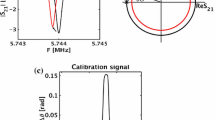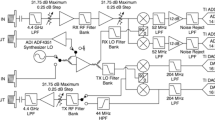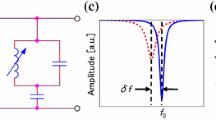Abstract
Microwave kinetic inductance detectors have a variety of potential applications in astronomical observations. We built a data acquisition system for kinetic inductance detectors combining a dedicated analog board and a commercially available digital board to meet the requirements of astronomical measurements, such as observation of the cosmic microwave background. This paper reports the status of the development of the data acquisition system. We have already achieved simultaneous readout through 120 channels using a direct down-conversion method to decode the signal. A variety of software has been developed and tested using the functionalities of the system and actual detectors.
Similar content being viewed by others
Avoid common mistakes on your manuscript.
1 Introduction
Astronomical observations have become increasingly sensitive in recent years with the use of superconducting detectors. One application of superconducting detectors is the observation of the cosmic microwave background (CMB), allowing the study of the very beginning of the Universe. There are many existing studies [1,2,3] and future plans [4,5,6,7] related to using superconducting detectors as focal plane detectors of telescopes. The detector array for CMB observations has been increased in size to reduce the statistical effects of photon number fluctuation. Most experiments run or plan on using transition edge sensors for their detectors with a variety of readout techniques including time division multiplexing [8], digital frequency multiplexing [9] and microwave multiplexing [10], to attain a high multiplexing number. Yet there is a detector design other than the transition edge sensor for experiments requiring many pixels.
A microwave kinetic inductance detector (MKID) is a superconducting resonator implemented on a chip with a thin film and has high scalability regardless of its simple design and operation principle [11] (Fig. 1). Energy introduced in the superconducting resonator breaks Cooper pairs and thus affects the surface impedance. The resonant circuit produces a fine dip with quality factor \(Q \sim \mathcal {O}(10^{5-6})\) in the transmission spectrum. The slight change in the surface impedance due to the breaking of Cooper pairs affects the shape of the dip such that there is a lower resonant frequency and broader dip (i.e., lower quality factor). Phase retardation also occurs as depicted in Fig. 1d.
The multiplexing of MKIDs in the frequency domain is realized by aligning resonators with different lengths beside a microwave feed line. We detect changes in the resonances simultaneously by introducing multicolor microwave tones corresponding to resonance frequencies and measuring transmission coefficients for each tone. Readout electronics for MKIDs thus need functions to produce a multicolor carrier wave and to measure transmission coefficients from the microwave returned through the feed line for MKIDs.
This paper presents the status of the development of a data acquisition system for MKIDs, especially for astronomical observation.
a, b Energy introduced in resonators breaking Cooper pairs and changing the surface impedance. c, d Transmission spectrum of the amplitude (c) and phase (d). Changes in the surface impedance resulting in a lower resonance frequency, broader dip, and phase rotation [11] (Color figure online)
Left Schematic of the readout system. The system comprises a digital board for data processing and an analog board that sends and receives IF waves. The carrier wave from DACs on the analog board is up-converted to an RF microwave and then passes through a chip. The returned wave from the detector is down-converted to the IF and then received by ADCs. Right Output of 120 tones after up-conversion measured using a spectrum analyzer. The center tone at 4 GHz is a leakage of the local oscillator (Color figure online)
2 Detail of the Readout System
The left panel of Fig. 2 is a schematic of the data acquisition system that we have developed. The system comprises a digital board for data processing and an analog board that sends and receives an IF wave. The carrier wave from digital-to-analog converters (DACs) on the analog board is up-converted to a radio frequency (RF) microwave and then passes through a chip. The returned wave from the detector is down-converted to the intermediate frequency (IF) and then received by analog-to-digital converters (ADCs). The digital board calculates transmission coefficients for each tone and down-samples them to reduce the data size. The control of the data acquisition and the data transmission are realized via Ethernet using the UDP and the TCP protocol, respectively.
The following subsections provide detailed descriptions of the analog and digital parts of the readout system.
2.1 Analog Board “RHEA”
We developed a dedicated analog board “RHEA” for the readout system[12]. The board has two pairs of a 14-bit ADC and 16-bit DAC operating at 200 MSPS, with the high bit resolution providing wide dynamic range without losing sensitivity. RHEA also has low power consumption and low heat emission in comparison with commercially available analog boards that support stable operation, which is important to astronomical observations.
The RHEA board is completely separable from the digital part. The board is equipped with a FPGA mezzanine card (FMC) low pin count (LPC) connector for control and data transmission. This is a standard connector for commercially available FPGA evaluation boards and thus allows a wide range of possible choices for the digital part.
2.2 Digital Processing with an FPGA
We chose direct down-conversion (DDC) [13] for our digital processing scheme. The DDC method allows the fine tuning of probe tone frequencies for each MKID, which is not the case when using the fast Fourier transformation [14]. This feature allows us to achieve maximum sensitivity for each MKID.
We developed the digital part of the readout system using the Xilinx FPGA evaluation board KCU105. The available number of logic cells is the key to attaining a high multiplexing number for the DDC method. We realized 120 multiplexing using a KCU105 board, which features a Kintex Ultrascale FPGA. The right panel of Fig. 2 shows an output of 120 tones after up-conversion to the \(4\pm 0.1\)-GHz band.
The processor is made up of copies of modules, each with a direct digital synthesizer (DDS), multiplexers, and accumulators. Digital processing of the FPGA is performed as follows. Tones are calculated by DDSs and then summed to create a multi-tone carrier wave, which is sent to the DACs. The return wave received by the ADCs is mixed with each DDS original wave to extract a corresponding signal, and the processor then calculates a complex transmission coefficient for each tone. IQ values after DDC and after accumulation have 31 and 56 bits, respectively, both without compression. The data rate of the final output is 1.8 MB/s for 1-kSPS acquisition.
3 Important Features of Our Readout System
The following summarizes important features of the readout system described so far. The measurements were taken using the GroundBIRD cryostat equipped with a sorption cooler and a cryostat with a dilution refrigerator.
3.1 Multiplexing Number
As described in Sect. 2, our readout system achieved a maximum multiplexing number of 120 employing the DDC method and a KCU105 board. We also confirmed that a KC705 board, whose FPGA has fewer logic cells, can be used for a multiplexing number of 64. These two versions of firmware are now available and actually used. The limitation of the multiplexing number is due to the number of logic cells in an FPGA, because an implementation of the DDC method requires a copy of DDC modules for each readout channel.
This multiplexing number fulfills our motivation for development. Our first goal is to apply this readout system to the CMB telescope “GroundBIRD” [15], whose focal plane detector has 110 MKIDs as described in the next section.
3.2 High-Speed Sampling and Wide Dynamic Range
Employing the DDC method allows sampling above 1MSPS without dead time. This in turn allows the characterization of MKIDs in detail. The left panel of Fig. 3 shows the noise power spectrum density (PSD) of an Al MKID cooled to 150 mK in the RIKEN cryostat measured using our readout system. This PSD contains information (e.g., the roll-off signature around 1 kHz) with which to characterize the device. The frequency of the PSD extends to \(5\times 10^5\) Hz, which directly reflects the high-speed sampling of our system.
The dynamic range of the analog board supports measurements free from digitization noise. Digitization noise is 60 dB below the expected noise level for ground-based CMB observation, and such a margin allows the characterization of detectors as in Fig. 3 during observation without reconfiguration of the readout setup. The noise floor appearing around \(-\,90\) dBc/Hz in the figure is due to room-temperature electronics outside the RHEA system. Despite there possibly being further room for optimization of the electronics, this level is far below the intrinsic noise of the detector appearing as a plateau around \(-\,60\) dBc/Hz.
3.3 Trigger Function
A high sampling rate also allows measurements of events with a small time constant, such as cosmic muon hits. However, normal data streaming to a host computer is inefficient for a rare event search because a limited data traffic capacity leads to a loss of available time.
The trigger function implemented on the digital board circumvents this problem through online selection. This function monitors baseline drift and detects jumps in a transmission coefficient for each tone. After the detection, the FPGA board sends time-ordered data before and after the jump. The threshold for the jump detection and the length of the data transmission before and after the jump are configurable with a UDP command before starting the measurement.
The right panel of Fig. 3 plots the response of a NbAl hybrid MKID to a muon hit measured using the trigger function. The detector is cooled to 250 mK using a sorption cooler installed in the GroundBIRD cryostat. The response has a characteristic feature that can be identified as a particle hit: a prompt rise followed by an exponential decay with a time constant corresponding to the quasiparticle lifetime. This demonstration shows that the system will be useful in the field of astroparticle physics when searching for rare events.
3.4 Portability
Our data acquisition system offers portability in that it operates without complicated preparation. Software for the data acquisition is written in Python and does not require the installation of special modules or the construction of a database server. Because the data transmission and control are realized via Ethernet with an ordinary protocol (i.e., TCP or UDP), there is no need for additional hardware or driver software for a host computer. These advantages greatly enhance the handiness of the system, and we simply need to plug in an Ethernet cable and run a Python script to start a measurement.
We have demonstrated the portability by installing our system at several institutes. Copies of this system now work in three different locations: High Energy Accelerator Research Organization (KEK), RIKEN, and Research Center for Neutrino Science (RCNS) at Tohoku University.
Left GroundBIRD telescope. The cryostat is mounted on a rotary table for high-speed rotational scanning. Right MKID array developed for the GroundBIRD telescope having two pairs of polarization antenna in each pixel [16] (Color figure online)
4 Applications
The system described so far has been developed for GroundBIRD [16], a CMB telescope with a novel scanning system. To achieve high sensitivity for a large angular scale, GroundBIRD employs high-speed rotational scanning. The left panel of Fig. 4 is an illustration of the GroundBIRD telescope. The cryostat mounted on the rotary table contains cold optics adopting a crossed-Dragone design, a pulse-tube cooler and a sorption refrigerator. Rotary joints supply helium gas and electricity through the table.
MKIDs well match the high-speed scan strategy of the GroundBIRD telescope in terms of their prompt time responses. The observation requires a high sampling rate (over 1 kSPS) and stable operation for the readout system; these requirements are well met by our system. The wide dynamic range of the analog board allows the characterization of detectors as in Fig. 3 without reconfiguration of the readout system, which will be helpful in controlling systematic uncertainty due to changes in the characteristics of MKIDs.
The right panel of Fig. 4 is a photograph of an MKID array developed for the GroundBIRD telescope. The array consists of 55 pixels, each with dual polarization antennae, implemented on a 3-inch wafer. A detailed view of a pixel is shown in the inset. Each polarization signal is read by an MKID. There are thus 110 MKIDs in an array.
GroundBIRD is now under testing in the laboratory and will be shipped to the Teide Observatory in the Canary Islands during the first half of 2018.
Although the data acquisition system was developed for the GroundBIRD experiment, it has the potential for a wide variety of use, including other astronomical observations and particle physics experiments searching for rare events. The developed firmware and software are open to the science community [17], and actually the number of users is growing.
5 Summary
We constructed a data acquisition system for MKIDs combining a RHEA analog board and a commercially available FPGA evaluation board. The system can realize a multiplexing number of 120, which meets the requirement of the CMB telescope GroundBIRD. Several tests were performed to show the feasibility of using the system for MKID readout.
References
P.A.R. Ade et al. [BICEP2 and Keck Array Collaborations], Phys. Rev. Lett. 116, 031302 (2016). https://doi.org/10.1103/PhysRevLett.116.031302. [arXiv:1510.09217 [astro-ph.CO]]
D. Hanson et al. [SPTpol Collaboration], Phys. Rev. Lett. 111, no. 14, 141301 (2013). https://doi.org/10.1103/PhysRevLett.111.141301. [arXiv:1307.5830 [astro-ph.CO]]
T. Louis et al. [ACTPol Collaboration], JCAP 1706, no. 06, 031 (2017). https://doi.org/10.1088/1475-7516/2017/06/031. [arXiv:1610.02360 [astro-ph.CO]]
J.A. Grayson et al. [BICEP3 Collaboration], Proc. SPIE Int. Soc. Opt. Eng. 9914, 99140S (2016). https://doi.org/10.1117/12.2233894. [arXiv:1607.04668 [astro-ph.IM]]
T. Matsumura et al., J. Low Temp. Phys. 176, 733 (2014). https://doi.org/10.1007/s10909-013-0996-1. [arXiv:1311.2847 [astro-ph.IM]]
A. Suzuki et al. [POLARBEAR Collaboration], J. Low. Temp. Phys. 184, no. 3–4, 805 (2016). https://doi.org/10.1007/s10909-015-1425-4. [arXiv:1512.07299 [astro-ph.IM]]
K.N. Abazajian et al. [CMB-S4 Collaboration]. arXiv:1610.02743 [astro-ph.CO]
J.A. Chervenak, K.D. Irwin, E.N. Grossman et al., Appl. Phys. Lett. 74, 4043 (1999)
T.M. Lanting, H.-M. Cho, J. Clarke et al., Nucl. Instrum. Methods Phys. Res. A 520, 548 (2004)
K.D. Irwin, K.W. Lehnert, Appl. Phys. Lett. 85, 2107 (2004)
P.K. Day, H.G. LeDuc, B.A. Mazin, A. Vayonakis, J. Zmuidzinas, Nature 425(6960), 817–821 (2003). 10
H. Ishitsuka, M. Ikeno, S. Oguri, O. Tajima, N. Tomita, T. Uchida, J. Low Temp. Phys. 184(1), 424–430 (2016)
O. Bourrion, A. Bideaud, A. Benoit, A. Cruciani, J. Macias-Perez, A. Monfardini, M. Roesch, L. Swenson, C. Vescovi. J. Instrum. 6(06), 06012
S.J.C. Yates, A.M. Baryshev, J.J.A. Baselmans, B. Klein, R. Güsten, Appl. Phys. Lett. 95(4), 042504 (2009). https://doi.org/10.1063/1.3159818
S. Oguri et al., J. Low Temp. Phys. 184(3–4), 786 (2016). https://doi.org/10.1007/s10909-015-1420-9
T. Nagasaki et al., J. Low Temp. Phys. LTD17 Special Issue, 2018 Submitted
E-mail: suzukij@post.kek.jp
Acknowledgements
This work is supported by Grants-in-Aid for Scientific Research from The Ministry of Education, Culture, Sports, Science and Technology, Japan (KAKENHI Grant Nos. 15H05743, 16J09435), the Center for the Promotion of Integrated Sciences of SOKENDAI, and the Basic Science Research Program through the National Research Foundation of Korea funded by the Ministry of Education, Science and Technology (Grant No. NRF-2017R1A2B3001968). We thank the Research Center for Neutrino Science, Tohoku University, and RIKEN Center for Advanced Photonics for their feedback on the readout system. We also acknowledge support from the Open Source Consortium of Instrumentation (Open-It).
Author information
Authors and Affiliations
Corresponding author
Rights and permissions
About this article
Cite this article
Suzuki, J., Ishitsuka, H., Lee, K. et al. Development of a Data Acquisition System for Kinetic Inductance Detectors: Wide Dynamic Range and High Sampling Rate for Astronomical Observation. J Low Temp Phys 193, 562–569 (2018). https://doi.org/10.1007/s10909-018-2033-x
Received:
Accepted:
Published:
Issue Date:
DOI: https://doi.org/10.1007/s10909-018-2033-x








